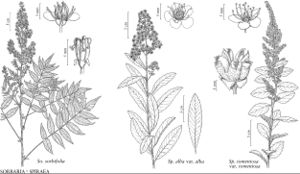Sorbaria
in P. F. A. Ascherson, Fl. Brandenburg 1: 177. 1860.
| Taxon | Illustrator ⠉ | |
|---|---|---|
 | Sorbaria sorbifolia Spiraea alba var. alba Spiraea tomentosa var. tomentosa | Marjorie C. Leggitt Marjorie C. Leggitt Marjorie C. Leggitt |
Shrubs, erect to spreading, [2–] 10–70 dm, vestiture simple, uniseriate or stellate hairs, often stipitate-glandular; rhizomatous, suckering. Stems 1–10+, widely arching; bark gray; long-shoots sparsely branched; glabrous or strongly pubescent and/or stellate, axillary buds ovoid to cylindric, bud-scales exposed, alternate, glabrous or pubescent or stipitate-stellate. Leaves deciduous, cauline, alternate, odd-pinnately compound; stipules obliquely adnate to petiole base, linear, lanceolate to ovate, margins entire or serrate, hairy ciliate; petiole present; blade oblong-ovate, 14–35 cm, herbaceous, leaflets (9–) 11–19 [–25], opposite along rachis, sessile, oblong-ovate to elliptic, margins flat, usually doubly serrate, with 0–6 teeth on each major tooth, surfaces glabrous or hairy. Inflorescences terminal, 15–1100+-flowered, panicles becoming pendulous when large, glabrous or pubescent and glandular; bracts present; bracteoles present. Pedicels present, short. Flowers (5–) 7–13 (–14) mm diam.; hypanthium shallowly cupshaped, 1.5–4.6 mm diam., glabrous or stellate-hairy; sepals 5, strongly reflexed, ovate-rounded to oblong-ovate; petals 5, white, ovate to orbicular, base short-clawed; stamens 17–35 [–50] usually in 1 series, much exceeding petals, those directly opposite petals sometimes much shorter, filaments glabrous; carpels 5, whorled, opposite sepals, basally and adaxially connate, laterally distinct, glabrous or pubescent, styles adaxial; ovules 4–8. Fruits aggregated follicles, 5, oblong, 3–6 mm, leathery, united to hypanthium at base, weakly so on adaxial margins, glabrous or pubescent, dehiscent along distal adaxial margin, adaxial margin often elongating and deflecting style to abaxial edge; hypanthium persistent; sepals persistent, reflexed, withering; styles not persistent. Seeds 4–8, fusiform, 4 mm. x = 9.
Distribution
Introduced; Asia (Afghanistan), Asia (c China), Asia (n India), Asia (Japan), Asia (Pakistan), Asia (e Russia), also in Europe
Discussion
Species 4 (2 in the flora).
Three species of Sorbaria are cultivated in North America, two of which are also escaping. Sorbaria tomentosa (Lindley) Rehder is recorded as cultivated in the United States and may naturalize; it differs from S. kirilowii in having fruiting styles borne near the fruit tip and simple, straight hairs scattered all along the midveins of abaxial leaf surfaces (not just on primary-secondary vein axils). It has two varieties: var. tomentosa, with leaflet margins doubly serrate, and var. angustifolia (Wenzig) Rahn (= S. aitchisonii Hemsley) with leaflets narrow (5–12 mm wide), abaxially glabrous, with the margins mostly only serrate, and vegetative branches purplish. They are native to eastern Afghanistan, northern India, and Pakistan.
Selected References
None.
Lower Taxa
Key
| 1 | Follicles and ovaries sericeous; sepals ovate to oblong-ovate, margins often glandular-serrate; stamens 20–35[–50], 2–6.5 mm (of variable length). | Sorbaria sorbifolia |
| 1 | Follicles and ovaries glabrous or nearly so; sepals ovate-rounded, margins entire; stamens 20–25, those opposite petals 1–1.5 mm, others 1.9–2.5(–4.5) mm. | Sorbaria kirilowii |
"thin" is not a number."dm" is not declared as a valid unit of measurement for this property.